Development of Estimation Models for Individual Tree Aboveground Biomass Based on TLS-Derived Parameters
Abstract
:1. Introduction
2. Materials and Methods
2.1. Study Area
2.2. Field Measurements
2.3. Collecting TLS Data
2.4. Variable Extraction
2.5. Model Development
2.5.1. Linear Model
2.5.2. Mixed-Effects Model
2.5.3. Random Forest Model
2.5.4. Artificial Neural Network Model
2.6. Model Evaluation
3. Results
3.1. Linear Model of Individual-Tree AGB Based on TLS-Derived Parameters
3.2. Mixed-Effects Model for Individual-Tree AGB Based on TLS-Derived Parameters
3.3. Random Forest Model for Individual-Tree AGB Based on TLS-Derived Parameters
3.3.1. Optimal Hyperparameters
3.3.2. Relative Importance and Partial Dependence
3.4. Artificial Neural Network Model for Individual-Tree AGB Based on TLS-Derived Parameters
3.5. Model Comparison
4. Discussion
5. Conclusions
Author Contributions
Funding
Data Availability Statement
Conflicts of Interest
Appendix A
| Variables | Interpretation |
|---|---|
| CL | Crown length |
| CLr | Crown ratio (CL/H) |
| CLcw | The length of crown above the height where maximum crown width is measured |
| CLrcw | The ratio of crown above the height where maximum crown width is measured (CLcw/H) |
| CLhcmin | The length of crown above the minimum height of the target crown contact with the adjacent crown |
| CLrhcmin | The ratio of crown above the minimum height of the target crown contact with the adjacent crown (CLhcmin/H) |
| CLhcmean | The length of crown above the mean height of the target crown contact with the adjacent crown |
| CLrhcmean | The ratio of crown above the mean height of the target crown contact with the adjacent crown (CLhcmean/H) |
| CLhcmax | The length of crown above the maximum height of the target crown contact with the adjacent crown |
| CLrhcmax | The ratio of crown above the maximum height of the target crown contact with the adjacent crown (CLhcmax/H) |
| CVcw | The volume of crown above the height where maximum crown width is measured |
| CScw | The surface area of crown above the height where maximum crown width is measured |
| CVhcmin | The volume of crown above the minimum height of the target crown contact with the adjacent crown |
| CShcmin | The surface area of crown above the minimum height of the target crown contact with the adjacent crown |
| CVhcmean | The volume of crown above the mean height of the target crown contact with the adjacent crown |
| CShcmean | The surface area of crown above the mean height of the target crown contact with the adjacent crown |
| CVhcmax | The volume of crown above the maximum height of the target crown contact with the adjacent crown |
| CShcmax | The surface area of crown above the maximum height of the target crown contact with the adjacent crown |
| CW | Maximum crown width |
| CRhcmin | Crown radius at minimum height of the target crown contact with the adjacent crown |
| CRhcmean | Crown radius at mean height of the target crown contact with the adjacent crown |
| CRhcmax | Crown radius at maximum height of the target crown contact with the adjacent crown |
| HB | Height of first live branch |
| Hcw | Height where the maximum crown width is measured |
| Hcmin | Minimum height of the target crown contact with the adjacent crown |
| Hcmean | Mean height of the target crown contact with the adjacent crown |
| Hcmax | maximum height of the target crown contact with the adjacent crown |
| Hp1~Hp99 | Percentile of height in normalized point cloud (1%, 5%, 10%, 20%, 25%, 30%, 40%, 50%, 60%, 70%, 75%, 80%, 90%, 95%, 99%) |
| Hmax | Maximum value of height in the normalized point cloud |
| Hmean | Mean value of height in the normalized point cloud |
| Hmin | Maximum value of height in the normalized point cloud |
| Hmed | Median of height in the normalized point cloud |
| Hstd | Standard deviation of height in the normalized point cloud |
| Hvar | Variance of height in the normalized point cloud |
| Hcv | Coefficients of variation of height in the normalized point cloud |
| Hskew | Skewness of height in the normalized point cloud |
| Hiq | Interquartile spacing of height percentile in the normalized point cloud |
References
- Dong, L.H.; Li, F.R. Stand-level biomass estimation models for the tree layer of main forest types in East Daxing’an Mountains, China. Chin. J. Appl. Ecol. 2018, 29, 2825–2834. [Google Scholar]
- Asrat, Z.; Eid, T.; Gobakken, T.; Negash, M. Aboveground tree biomass prediction options for the Dry Afromontane forests in south-central Ethiopia. For. Ecol. Manag. 2020, 473, 118335. [Google Scholar] [CrossRef]
- Ter-Mikaelian, M.T.; Korzukhin, M.D. Biomass equations for sixty-five North American tree species. For. Ecol. Manag. 1997, 97, 1–24. [Google Scholar] [CrossRef]
- Wang, J.; Zhang, L.; Feng, Z. Allometric Equations for the Aboveground Biomass of Five Tree Species in China Using the Generalized Method of Moments. For. Chron. 2018, 94, 7. [Google Scholar]
- Roxburgh, S.H.; Paul, K.I.; Clifford, D.; England, J.R.; Raison, R.J. Guidelines for constructing allometric models for the prediction of woody biomass: How many individuals to harvest? Ecosphere 2015, 6, 1–27. [Google Scholar] [CrossRef]
- Repola, J. Biomass equations for Scots pine and Norway spruce in Finland. Silva Fenn. 2009, 43, 184. [Google Scholar] [CrossRef]
- Lefsky, M.A. Application of Lidar Remote Sensing to the Estimation of Forest Canopy and Stand Structure; UMI: Ann Arbor, MI, USA, 1997. [Google Scholar]
- Musthafa, M.; Singh, G. Forest above-ground woody biomass estimation using multi-temporal space-borne LiDAR data in a managed forest at Haldwani, India. Adv. Space Res. 2022, 69, 3245–3257. [Google Scholar] [CrossRef]
- Pastor, J.; Aber, J.D.; Melillo, J.M. Biomass prediction using generalized allometric regressions for some northeast tree species. For. Ecol. Manag. 1984, 7, 265–274. [Google Scholar] [CrossRef]
- Kuyah, S.; Dietz, J.; Muthuri, C.; van Noordwijk, M.; Neufeldt, H. Allometry and partitioning of above- and below-ground biomass in farmed eucalyptus species dominant in Western Kenyan agricultural landscapes. Biomass-Bioenergy 2013, 55, 276–284. [Google Scholar] [CrossRef]
- Huy, B.; Kralicek, K.; Poudel, K.P.; Phuong, V.T.; Van Khoa, P.; Hung, N.D.; Temesgen, H. Allometric equations for estimating tree aboveground biomass in evergreen broadleaf forests of Viet Nam. For. Ecol. Manag. 2016, 382, 193–205. [Google Scholar] [CrossRef]
- Täll, K. Accuracy of Mobile Forest Inventory Application KatamTM Forest. Second Cycle, A2E; Southern Swedish Forest Research Centre, SLU: Alnarp, Sweden, 2020. [Google Scholar]
- Mankou, G.S.; Ligot, G.; Panzou, G.J.L.; Boyemba, F.; Loumeto, J.J.; Ngomanda, A.; Obiang, D.; Rossi, V.; Sonke, B.; Yongo, O.D.; et al. Tropical tree allometry and crown allocation, and their relationship with species traits in central Africa. For. Ecol. Manag. 2021, 493, 119262. [Google Scholar] [CrossRef]
- Kükenbrink, D.; Gardi, O.; Morsdorf, F.; Thürig, E.; Schellenberger, A.; Mathys, L. Above-ground biomass references for urban trees from terrestrial laser scanning data. Ann. Bot. 2021, 128, 709–724. [Google Scholar] [CrossRef]
- Feng, Z.; Luo, X.; Ma, Q.Y.; Hao, X.Y.; Chen, X.X.; Zhao, L.G. An estimation of tree canopy biomass based on 3D laser scanning imaging system. J. Beijing For. Univ. 2007, 29, 52–56. [Google Scholar]
- Evangelista, P.; Kumar, S.; Stohlgren, T.J.; Crall, A.W.; Newman, G.J. Modeling Aboveground Biomass of Tamarix Ramosissima in the Arkansas River Basin of Southeastern Colorado, USA. West. N. Am. Nat. 2007, 67, 503–509. [Google Scholar] [CrossRef]
- Zhang, H.R.; Tang, S.Z.; Wang, F.Y. Study on Estabilish and Estimate Method of Biomass Model Compatible with Volume. For. Res. 1999, 12, 56–62. [Google Scholar]
- Huang, X.Z.; Sun, X.M.; Zhang, S.G.; Chen, D. Compatible Biomass Models for Larix kaempferi in Mountainous Area of Eastern Liaoning. For. Res. 2014, 27, 142–148. [Google Scholar] [CrossRef]
- Goodman, R.C.; Phillips, O.L.; Baker, T.R. The importance of crown dimensions to improve tropical tree biomass estimates. Ecol. Appl. 2014, 24, 680–698. [Google Scholar] [CrossRef]
- Wang, M.; Im, J.; Zhao, Y.; Zhen, Z. Multi-Platform LiDAR for Non-Destructive Individual Aboveground Biomass Estimation for Changbai Larch (Larix olgensis Henry) Using a Hierarchical Bayesian Approach. Remote Sens. 2022, 14, 4361. [Google Scholar] [CrossRef]
- Wang, M.; Liu, Q.; Fu, L.; Wang, G.; Zhang, X. Airborne LIDAR-Derived Aboveground Biomass Estimates Using a Hierarchical Bayesian Approach. Remote Sens. 2019, 11, 1050. [Google Scholar] [CrossRef]
- Li, F.R.; Wang, Z.F.; Wang, B.S. Studies on the effective crown development of larix olgensis (I)-determination of the effective crown. J. Northeast For. Univ. 1996, 24, 1–8. [Google Scholar]
- Zheng, Y.; Jia, W.; Wang, Q.; Huang, X. Deriving Individual-Tree Biomass from Effective Crown Data Generated by Terrestrial Laser Scanning. Remote Sens. 2019, 11, 2793. [Google Scholar] [CrossRef]
- Wang, Q.; Pang, Y.; Chen, D.; Liang, X.; Lu, J. Lidar biomass index: A novel solution for tree-level biomass estimation using 3D crown information. For. Ecol. Manag. 2021, 499, 119542. [Google Scholar] [CrossRef]
- Disney, M.I.; Vicari, M.B.; Burt, A.; Calders, K.; Lewis, S.L.; Raumonen, P.; Wilkes, P. Weighing trees with lasers: Advances, challenges and opportunities. Interface Focus 2018, 8, 20170048. [Google Scholar] [CrossRef]
- Hudak, A.T.; Strand, E.K.; Vierling, L.A.; Byrne, J.C.; Eitel, J.U.; Martinuzzi, S.; Falkowski, M.J. Quantifying aboveground forest carbon pools and fluxes from repeat LiDAR surveys. Remote Sens. Environ. 2012, 123, 25–40. [Google Scholar] [CrossRef]
- Ahmed, R.; Siqueira, P.; Hensley, S. A study of forest biomass estimates from lidar in the northern temperate forests of New England. Remote Sens. Environ. 2013, 130, 121–135. [Google Scholar] [CrossRef]
- Lim, K.; Treitz, P.; Wulder, M.; St-Onge, B.; Flood, M. LiDAR remote sensing of forest structure. Prog. Phys. Geogr. Earth Environ. 2003, 27, 88–106. [Google Scholar] [CrossRef]
- Dassot, M.; Constant, T.; Fournier, M. The use of terrestrial LiDAR technology in forest science: Application fields, benefits and challenges. Ann. For. Sci. 2011, 68, 959–974. [Google Scholar] [CrossRef]
- Fernández-Sarría, A.; Martínez, L.; Velázquez-Martí, B.; Sajdak, M.; Estornell, J.; Recio, J. Different methodologies for calculating crown volumes of Platanus hispanica trees using terrestrial laser scanner and a comparison with classical dendrometric measurements. Comput. Electron. Agric. 2012, 90, 176–185. [Google Scholar] [CrossRef]
- Maas, H.-G.; Bienert, A.; Scheller, S.; Keane, E. Automatic forest inventory parameter determination from terrestrial laser scanner data. Int. J. Remote Sens. 2008, 29, 1579–1593. [Google Scholar] [CrossRef]
- Olofsson, K.; Holmgren, J.; Olsson, H. Tree Stem and Height Measurements using Terrestrial Laser Scanning and the RANSAC Algorithm. Remote Sens. 2014, 6, 4323–4344. [Google Scholar] [CrossRef]
- Srinivasan, S.; Popescu, S.; Eriksson, M.; Sheridan, R.; Ku, N.-W.J.R.S. Terrestrial Laser Scanning as an Effective Tool to Retrieve Tree Level Height, Crown Width, and Stem Diameter. Remote Sens. 2015, 7, 1877–1896. [Google Scholar] [CrossRef]
- Moskal, L.M.; Zheng, G. Retrieving Forest Inventory Variables with Terrestrial Laser Scanning (TLS) in Urban Heterogeneous Forest. Remote Sens. 2012, 4, 1–20. [Google Scholar] [CrossRef]
- Bogdanovich, E.; Perez-Priego, O.; El-Madany, T.S.; Guderle, M.; Pacheco-Labrador, J.; Levick, S.R.; Moreno, G.; Carrara, A.; Martín, M.P.; Migliavacca, M. Using terrestrial laser scanning for characterizing tree structural parameters and their changes under different management in a Mediterranean open woodland. For. Ecol. Manag. 2021, 486, 118945. [Google Scholar] [CrossRef]
- Saarinen, N.; Kankare, V.; Vastaranta, M.; Luoma, V.; Pyörälä, J.; Tanhuanpää, T.; Liang, X.; Kaartinen, H.; Kukko, A.; Jaakkola, A.; et al. Feasibility of Terrestrial laser scanning for collecting stem volume information from single trees. ISPRS J. Photogramm. Remote Sens. 2017, 123, 140–158. [Google Scholar] [CrossRef]
- Liang, X.; Kankare, V.; Yu, X.; Hyyppa, J.; Holopainen, M. Automated stem curve measurement using terrestrial laser scanning. IEEE Trans. Geosci. Remote 2014, 52, 1739–1748. [Google Scholar] [CrossRef]
- Luoma, V.; Saarinen, N.; Kankare, V.; Tanhuanpää, T.; Kaartinen, H.; Kukko, A.; Holopainen, M.; Hyyppä, J.; Vastaranta, M. Examining Changes in Stem Taper and Volume Growth with Two-Date 3D Point Clouds. Forests 2019, 10, 382. [Google Scholar] [CrossRef]
- Zhu, Z.; Kleinn, C.; Nölke, N. Towards Tree Green Crown Volume: A Methodological Approach Using Terrestrial Laser Scanning. Remote Sens. 2020, 12, 1841. [Google Scholar] [CrossRef]
- Han, T.; Sánchez-Azofeifa, G.A. Extraction of Liana Stems Using Geometric Features from Terrestrial Laser Scanning Point Clouds. Remote Sens. 2022, 14, 4039. [Google Scholar] [CrossRef]
- Zhou, L.; Li, X.; Zhang, B.; Xuan, J.; Gong, Y.; Tan, C.; Huang, H.; Du, H. Estimating 3D Green Volume and Aboveground Biomass of Urban Forest Trees by UAV-Lidar. Remote Sens. 2022, 14, 5211. [Google Scholar] [CrossRef]
- Rahman, M.Z.A.; Abu Bakar, A.; Razak, K.A.; Rasib, A.W.; Kanniah, K.D.; Kadir, W.H.W.; Omar, H.; Faidi, A.; Kassim, A.R.; Latif, Z.A. Non-Destructive, Laser-Based Individual Tree Aboveground Biomass Estimation in a Tropical Rainforest. Forests 2017, 8, 86. [Google Scholar] [CrossRef]
- Stovall, A.E.; Vorster, A.G.; Anderson, R.S.; Evangelista, P.H.; Shugart, H.H. Non-destructive aboveground biomass estimation of coniferous trees using terrestrial LiDAR. Remote Sens. Environ. 2017, 200, 31–42. [Google Scholar] [CrossRef]
- Brede, B.; Calders, K.; Lau, A.; Raumonen, P.; Bartholomeus, H.M.; Herold, M.; Kooistra, L. Non-destructive tree volume estimation through quantitative structure modelling: Comparing UAV laser scanning with terrestrial LIDAR. Remote Sens. Environ. 2019, 233, 111355. [Google Scholar] [CrossRef]
- Gao, L.; Chai, G.; Zhang, X. Above-Ground Biomass Estimation of Plantation with Different Tree Species Using Airborne LiDAR and Hyperspectral Data. Remote Sens. 2022, 14, 2568. [Google Scholar] [CrossRef]
- Kankare, V.; Holopainen, M.; Vastaranta, M.; Puttonen, E.; Yu, X.; Hyyppä, J.; Vaaja, M.; Hyyppä, H.; Alho, P. Individual tree biomass estimation using terrestrial laser scanning. ISPRS J. Photogramm. Remote Sens. 2013, 75, 64–75. [Google Scholar] [CrossRef]
- Yao, T.; Yang, X.; Zhao, F.; Wang, Z.; Zhang, Q.; Jupp, D.; Lovell, J.; Culvenor, D.; Newnham, G.; Ni-Meister, W.; et al. Measuring forest structure and biomass in New England forest stands using Echidna ground-based lidar. Remote Sens. Environ. 2011, 115, 2965–2974. [Google Scholar] [CrossRef]
- Fehrmann, L.; Lehtonen, A.; Kleinn, C.; Tomppo, E. Comparison of linear and mixed-effect regression models and a k-nearest neighbour approach for estimation of single-tree biomass. Can. J. For. Res. 2008, 38, 1–9. [Google Scholar] [CrossRef]
- Fehrmann, L.; Kleinn, C. General considerations about the use of allometric equations for biomass estimation on the example of Norway spruce in central Europe. For. Ecol. Manag. 2006, 236, 412–421. [Google Scholar] [CrossRef]
- Cienciala, E.; Černý, M.; Tatarinov, F.; Apltauer, J.; Exnerová, Z. Biomass functions applicable to Scots pine. Trees 2006, 20, 483–495. [Google Scholar] [CrossRef]
- Ashraf, I.; Zhao, Z.; Bourque, C.P.-A.; MacLean, D.; Meng, F.-R. Integrating biophysical controls in forest growth and yield predictions with artificial intelligence technology. Can. J. For. Res. 2013, 43, 1162–1171. [Google Scholar] [CrossRef]
- Özçelik, R.; Diamantopoulou, M.J.; Eker, M.; Gürlevik, N. Artificial Neural Network Models: An Alternative Approach for Reliable Aboveground Pine Tree Biomass Prediction. For. Sci. 2017, 63, 291–302. [Google Scholar] [CrossRef]
- Purohit, S.; Aggarwal, S.P.; Patel, N.R. Estimation of forest aboveground biomass using combination of Landsat 8 and Sentinel-1A data with random forest regression algorithm in Himalayan Foothills. Trop. Ecol. 2021, 62, 288–300. [Google Scholar] [CrossRef]
- Dong, L.; Du, H.; Han, N.; Li, X.; Zhu, D.; Mao, F.; Zhang, M.; Zheng, J.; Liu, H.; Huang, Z.; et al. Application of Convolutional Neural Network on Lei Bamboo Above-Ground-Biomass (AGB) Estimation Using Worldview-2. Remote Sens. 2020, 12, 958. [Google Scholar] [CrossRef]
- Vahedi, A.A. Artificial neural network application in comparison with modeling allometric equations for predicting above-ground biomass in the Hyrcanian mixed-beech forests of Iran. Biomass-Bioenergy 2016, 88, 66–76. [Google Scholar] [CrossRef]
- Li, X.; Du, H.; Mao, F.; Zhou, G.; Chen, L.; Xing, L.; Fan, W.; Xu, X.; Liu, Y.; Cui, L.; et al. Estimating bamboo forest aboveground biomass using EnKF-assimilated MODIS LAI spatiotemporal data and machine learning algorithms. Agric. For. Meteorol. 2018, 256–257, 445–457. [Google Scholar] [CrossRef]
- Jenkins, J.C.; Chojnacky, D.C.; Heath, L.S.; Birdsey, R.A. National-Scale Biomass Estimators for United States Tree Species. For. Sci. 2003, 49, 12–35. [Google Scholar] [CrossRef]
- Dong, L.H.; Li, F.R.; Jia, W. Development of tree biomass model for Pinus koraiensis plantation. J. Beijing For. Univ. 2012, 34, 16–22. [Google Scholar] [CrossRef]
- Boudreau, J.; Nelson, R.F.; Margolis, H.A.; Beaudoin, A.; Guindon, L.; Kimes, D.S. Regional aboveground forest biomass using airborne and spaceborne LiDAR in Québec. Remote Sens. Environ. 2008, 112, 3876–3890. [Google Scholar] [CrossRef]
- Asner, G.P.; Mascaro, J. Mapping tropical forest carbon: Calibrating plot estimates to a simple LiDAR metric. Remote Sens. Environ. 2014, 140, 614–624. [Google Scholar] [CrossRef]
- Edelsbrunner, H.; Kirkpatrick, D.; Seidel, R. On the shape of a set of points in the plane. IEEE Trans. Inf. Theory 1983, 29, 551–559. [Google Scholar] [CrossRef]
- Edelsbrunner, H. Smooth Surfaces for Multi-Scale Shape Representation. In Proceedings of the Foundations of Software Technology and Theoretical Computer Science; Thiagarajan, P.S., Ed.; Springer: Berlin/Heidelberg, Germany, 1995; pp. 391–412. [Google Scholar]
- Melkman, A.A. On-line construction of the convex hull of a simple polyline. Inf. Process. Lett. 1987, 25, 11–12. [Google Scholar] [CrossRef]
- Chen, M.; Qiu, X.; Zeng, W.; Peng, D. Combining Sample Plot Stratification and Machine Learning Algorithms to Improve Forest Aboveground Carbon Density Estimation in Northeast China Using Airborne LiDAR Data. Remote Sens. 2022, 14, 1477. [Google Scholar] [CrossRef]
- Sun, G.; Ranson, K.J.; Guo, Z.; Zhang, Z.; Montesano, P.; Kimes, D. Forest biomass mapping from lidar and radar synergies. Remote Sens. Environ. 2011, 115, 2906–2916. [Google Scholar] [CrossRef]
- Li, Y.C.; Tang, S.Z. Establishment of Tree Height Growth Model Based on Mixed and Nlmixed of SAS. For. Res. 2004, 17, 279–283. [Google Scholar]
- Random Forests. Available online: https://www.semanticscholar.org/paper/Random-Forests-Breiman/13d4c2f76a7c1a4d0a71204e1d5d263a3f5a7986 (accessed on 12 September 2022).
- Hu, T.; Su, Y.; Xue, B.; Liu, J.; Zhao, X.; Fang, J.; Guo, Q. Mapping Global Forest Aboveground Biomass with Spaceborne LiDAR, Optical Imagery, and Forest Inventory Data. Remote Sens. 2016, 8, 565. [Google Scholar] [CrossRef]
- Ketkar, N. Introduction to Keras. In Deep Learning with Python; APress: New York, NY, USA, 2017; pp. 95–109. ISBN 978-1-4842-2765-7. [Google Scholar]
- Heaton, J. Ian Goodfellow, Yoshua Bengio, and Aaron Courville: Deep Learning; The MIT Press: Cambridge, MA, USA, 2016; 800p, ISBN 0-262-03561-8. [Google Scholar]
- Sun, Y.; Ao, Z.; Jia, W.; Chen, Y.; Xu, K. A geographically weighted deep neural network model for research on the spatial distribution of the down dead wood volume in Liangshui National Nature Reserve (China). iForest—Biogeosci. For. 2021, 14, 353–361. [Google Scholar] [CrossRef]
- Cheng, G.; Wang, J.; Yang, J.; Zhao, Z.; Wang, L. Calculation Method of 3D Point Cloud Canopy Volume Based on Improved α-shape Algorithm. Trans. Chin. Soc. Agric. Mach. 2021, 52, 175–183. [Google Scholar]
- Fernández-Sarría, A.; Velázquez-Martí, B.; Sajdak, M.; Martínez, L.; Estornell, J. Residual biomass calculation from individual tree architecture using terrestrial laser scanner and ground-level measurements. Comput. Electron. Agric. 2013, 93, 90–97. [Google Scholar] [CrossRef]
- Xu, W.-H.; Feng, Z.-K.; Su, Z.-F.; Xu, H.; Jiao, Y.-Q.; Deng, O. An automatic extraction algorithm for individual tree crown projection area and volume based on 3D point cloud data. Spectrosc. Spectr. Anal. 2014, 34, 465–471. [Google Scholar]
- Wei, X.; Wang, Y.; Zheng, J.; Wang, M.; Feng, Z. Tree Crown Volume Calculation Based on 3-D Laser Scanning Point Clouds Data. Trans. Chin. Soc. Agric. Mach. 2013, 44, 235–240. [Google Scholar]
- Hosoi, F.; Nakai, Y.; Omasa, K. 3-D voxel-based solid modeling of a broad-leaved tree for accurate volume estimation using portable scanning lidar. ISPRS J. Photogramm. Remote Sens. 2013, 82, 41–48. [Google Scholar] [CrossRef]
- Su, Y.; Guo, Q.; Xue, B.; Hu, T.; Alvarez, O.; Tao, S.; Fang, J. Spatial distribution of forest aboveground biomass in China: Estimation through combination of spaceborne lidar, optical imagery, and forest inventory data. Remote Sens. Environ. 2016, 173, 187–199. [Google Scholar] [CrossRef]
- Fernández-Sarría, A.; López-Cortés, I.; Estornell, J.; Velázquez-Martí, B.; Salazar, D. Estimating residual biomass of olive tree crops using terrestrial laser scanning. Int. J. Appl. Earth Obs. Geoinf. 2019, 75, 163–170. [Google Scholar] [CrossRef]
- Lau, A.; Calders, K.; Bartholomeus, H.; Martius, C.; Raumonen, P.; Herold, M.; Vicari, M.; Sukhdeo, H.; Singh, J.; Goodman, R.C. Tree Biomass Equations from Terrestrial LiDAR: A Case Study in Guyana. Forests 2019, 10, 527. [Google Scholar] [CrossRef]
- Srinivasan, S.; Popescu, S.C.; Eriksson, M.; Sheridan, R.D.; Ku, N.-W. Multi-temporal terrestrial laser scanning for modeling tree biomass change. For. Ecol. Manag. 2014, 318, 304–317. [Google Scholar] [CrossRef]
- Quan, Y.; Li, M.; Zhen, Z.; Hao, Y.; Wang, B. The Feasibility of Modelling the Crown Profile of Larix olgensis Using Unmanned Aerial Vehicle Laser Scanning Data. Sensors 2020, 20, 5555. [Google Scholar] [CrossRef]

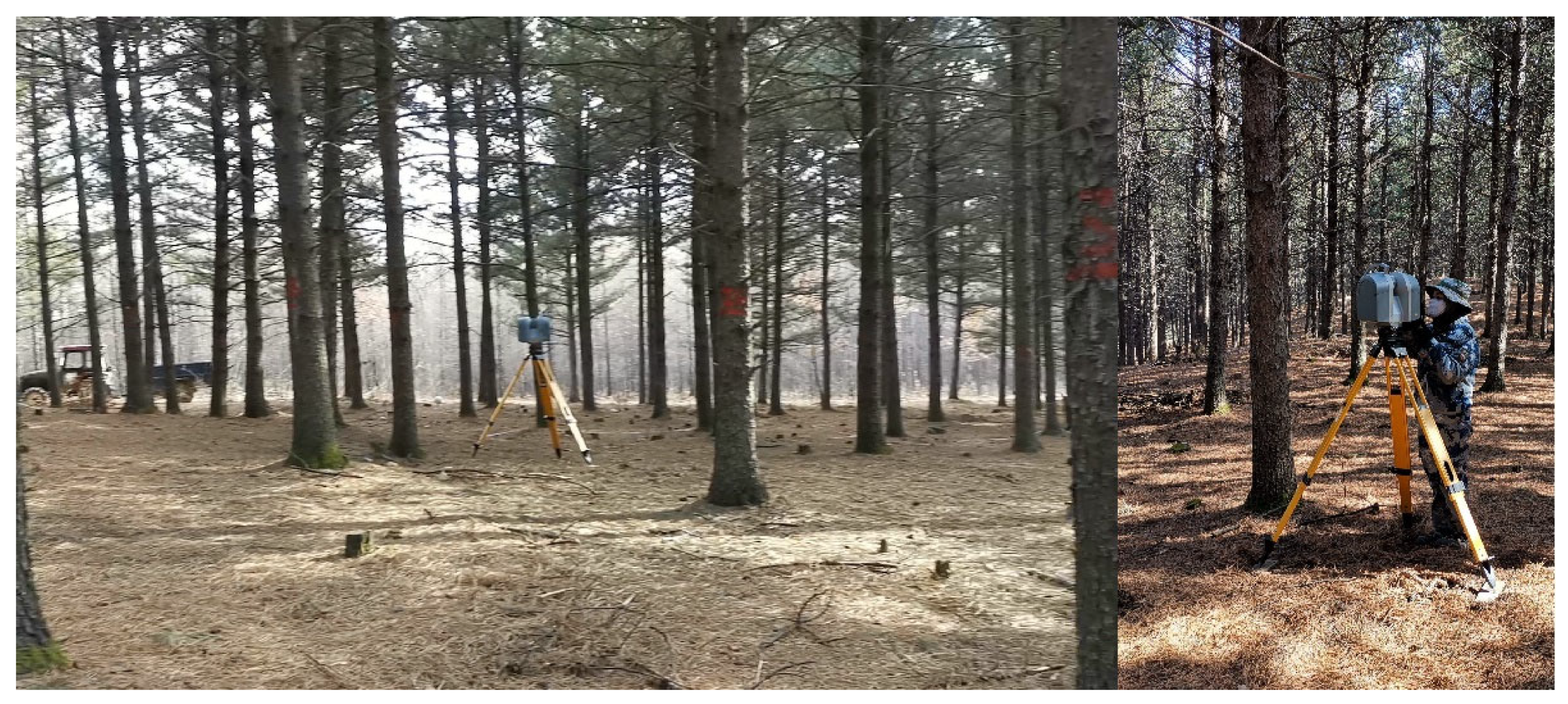
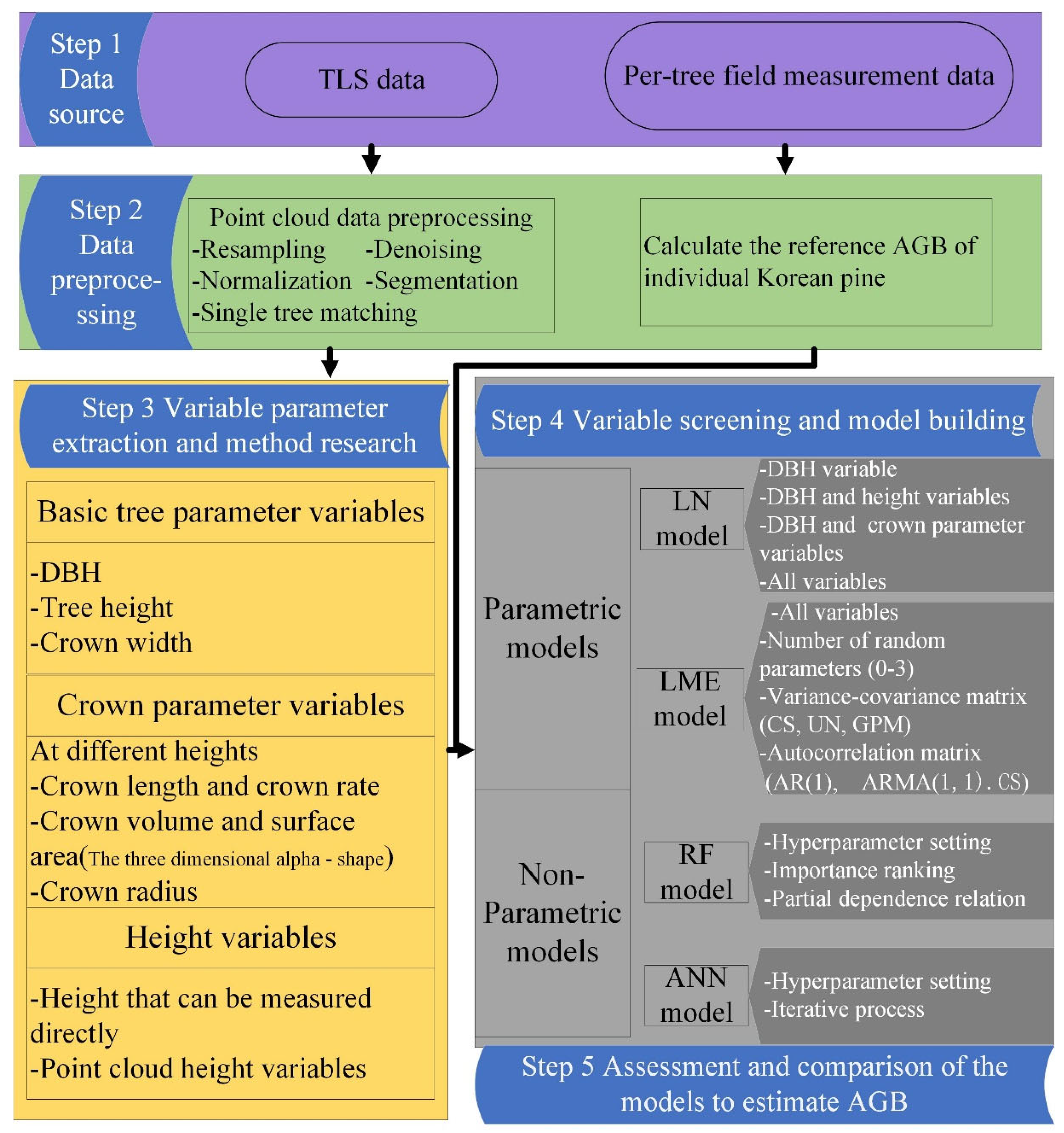
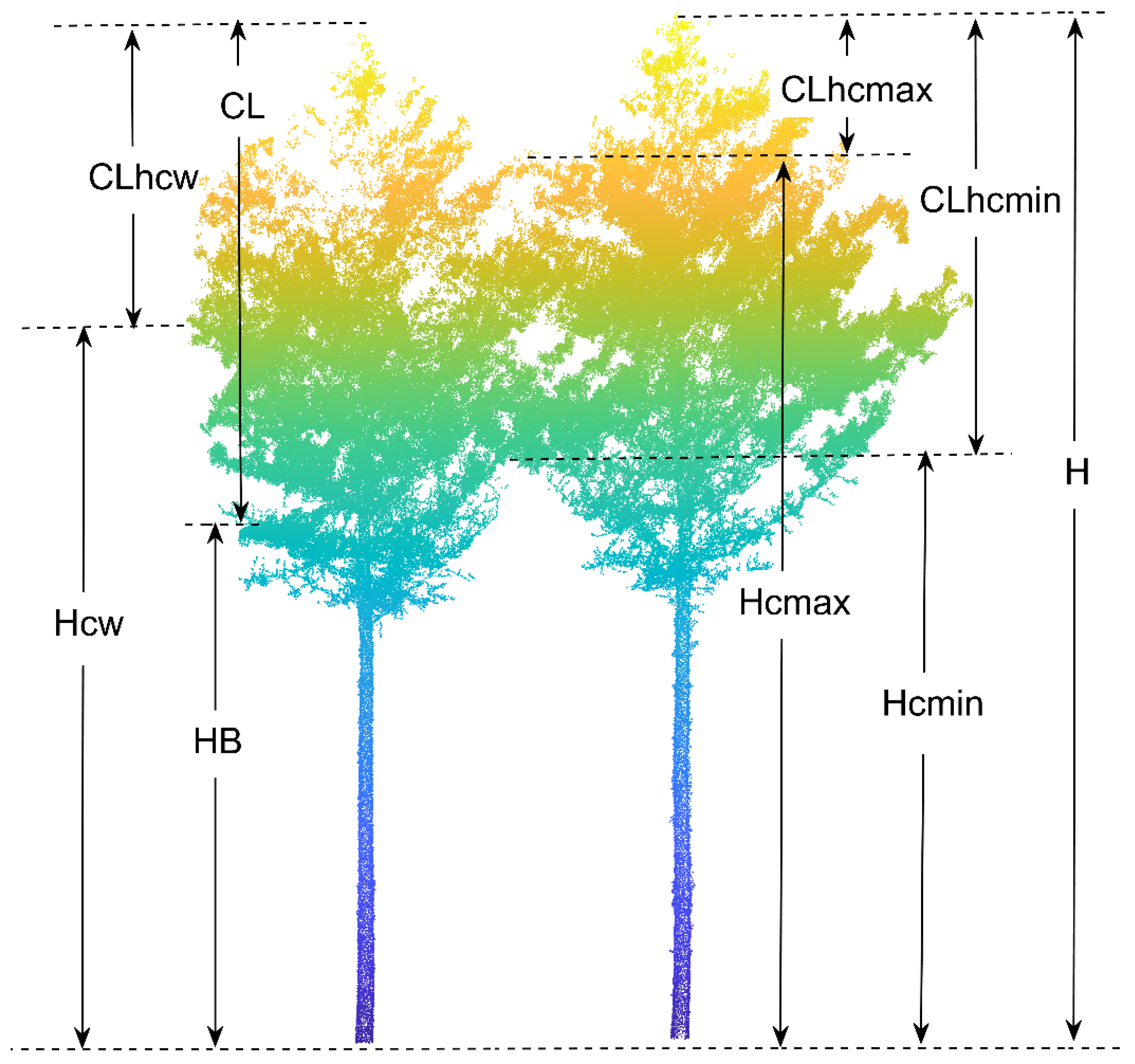

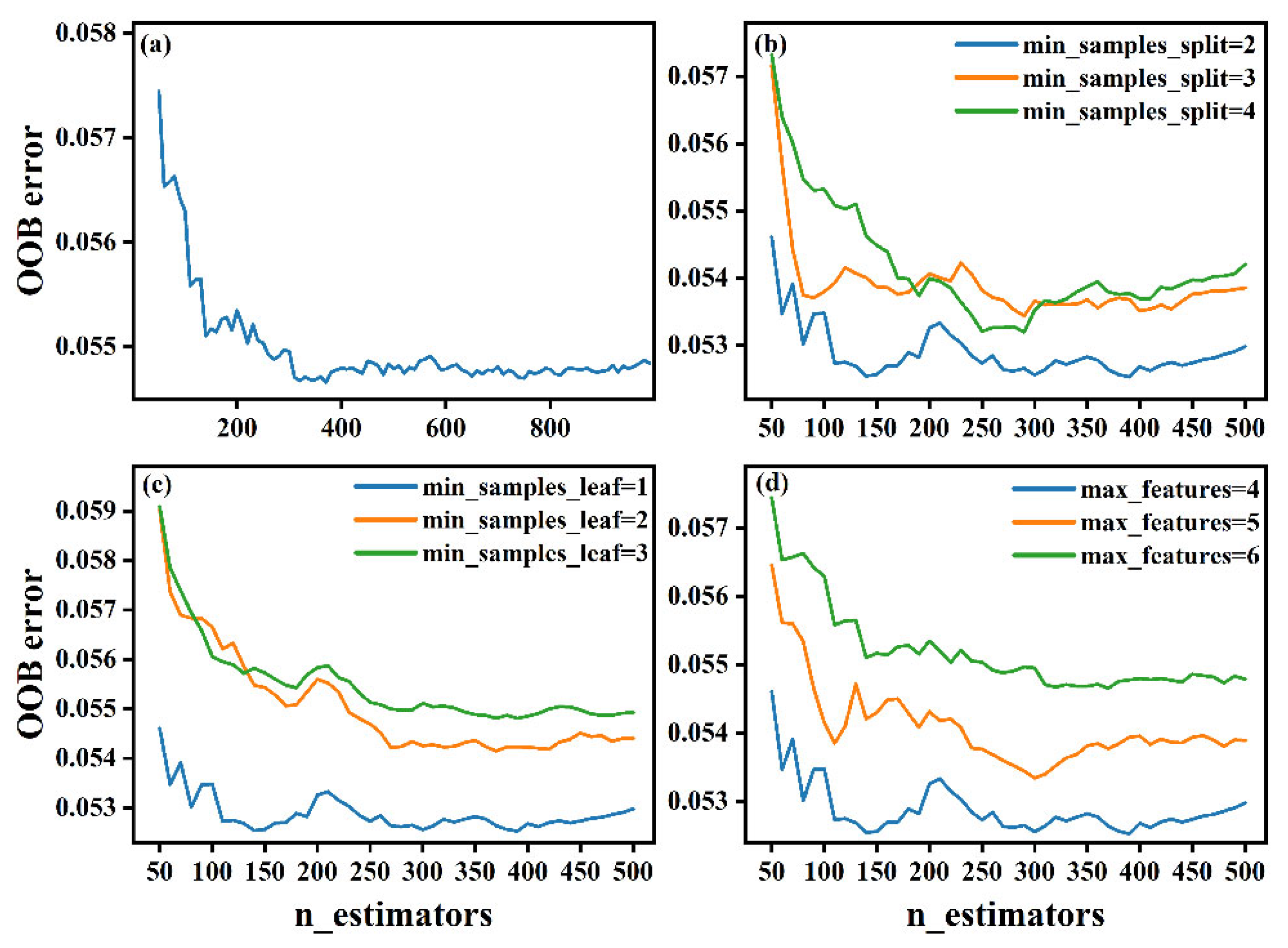
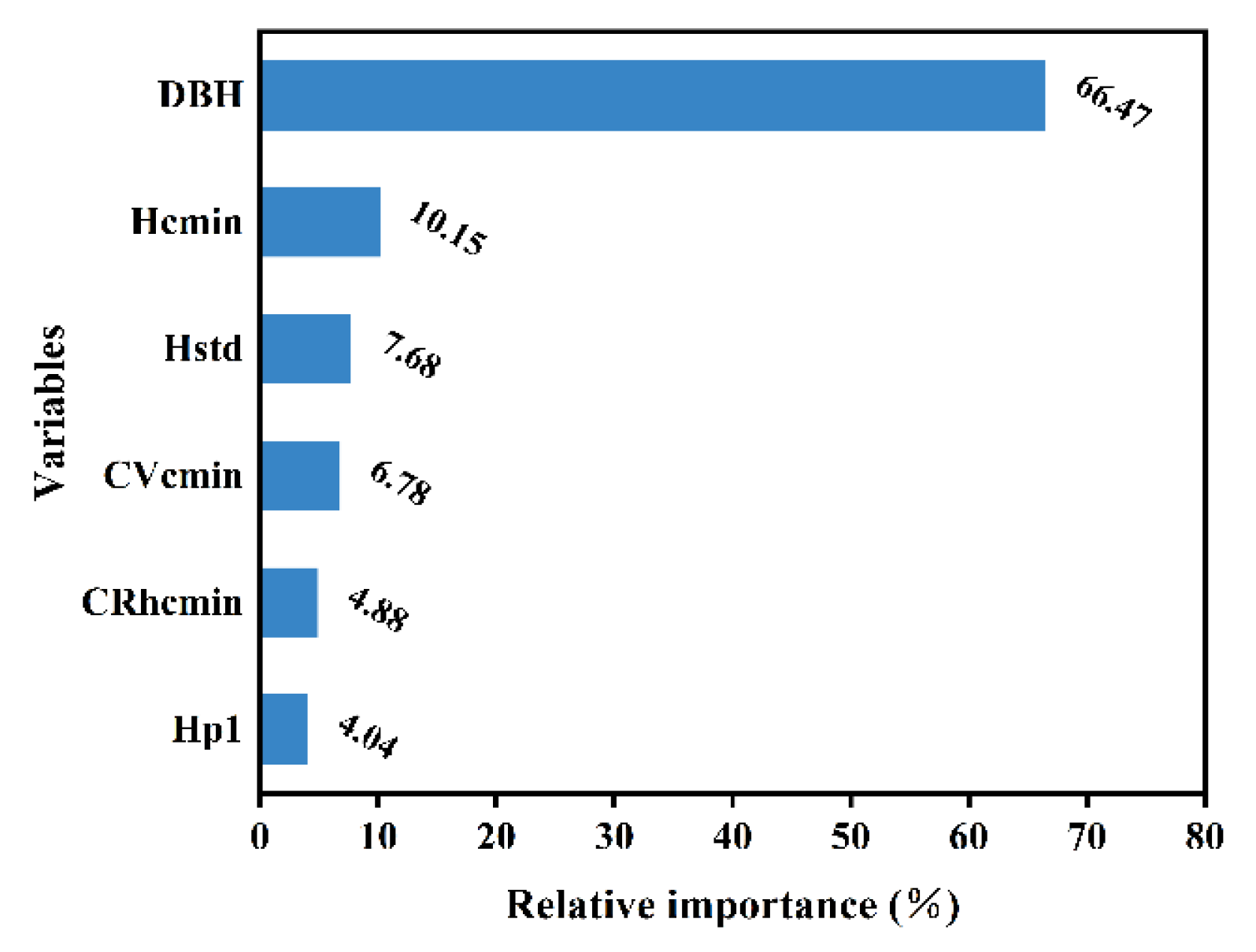

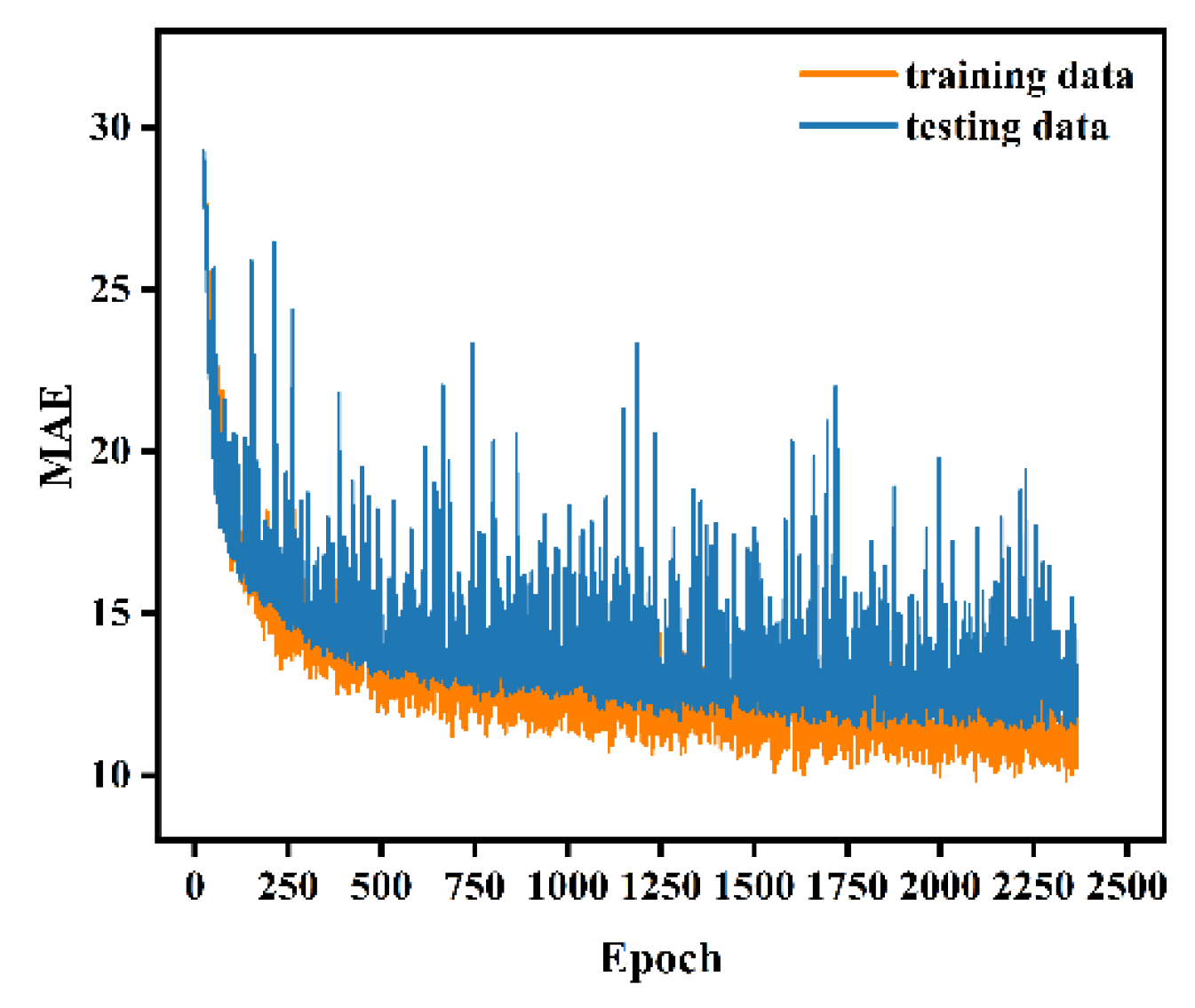
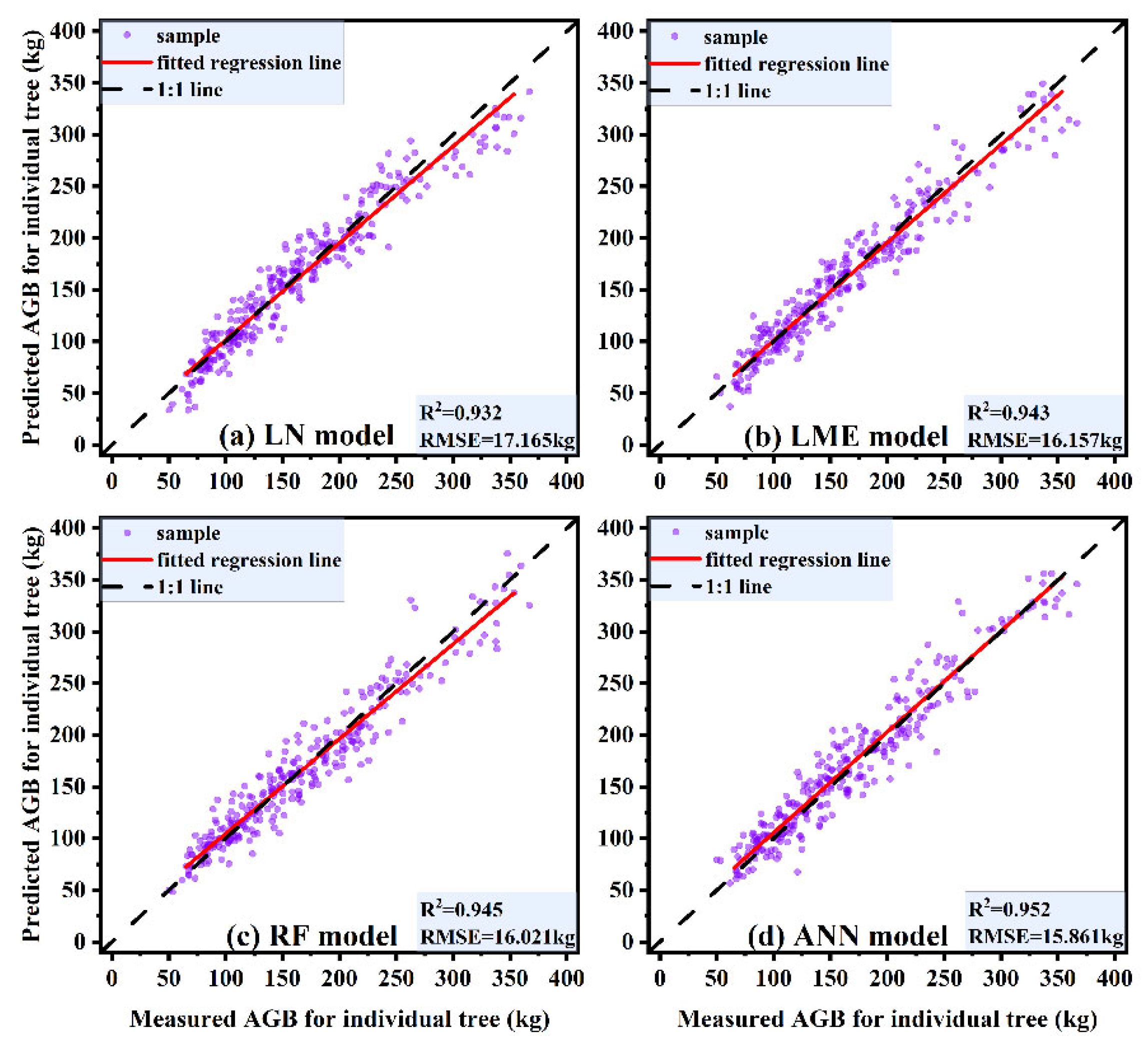
| Plots | DBH (cm) | TH (m) | CW (m) | HB (m) | Mean Age (a) | Area (hm2) | Density (N·hm−2) | ||||
|---|---|---|---|---|---|---|---|---|---|---|---|
| Mean | Std | Mean | Std | Mean | Std | Mean | Std | ||||
| 1 | 25.3 | 2.32 | 14.6 | 2.53 | 5.7 | 0.68 | 6.2 | 1.35 | 51 | 0.06 | 517 |
| 2 | 23.8 | 3.57 | 14.8 | 2.14 | 5.1 | 0.94 | 7.3 | 1.57 | 50 | 0.06 | 700 |
| 3 | 21.5 | 2.78 | 13.3 | 1.88 | 4.4 | 0.97 | 5.9 | 1.25 | 47 | 0.06 | 800 |
| 4 | 25.2 | 3.65 | 15.4 | 1.04 | 4.7 | 0.84 | 5.9 | 1.15 | 57 | 0.06 | 567 |
| 5 | 26.8 | 3.88 | 14.4 | 1.02 | 5.6 | 0.92 | 4.5 | 1.13 | 47 | 0.06 | 500 |
| 6 | 19.5 | 4.65 | 16.8 | 1.96 | 3.4 | 1.09 | 7.9 | 2.01 | 56 | 0.06 | 1200 |
| 7 | 21.9 | 3.93 | 17.9 | 2.31 | 3.8 | 1.00 | 9.2 | 2.04 | 54 | 0.09 | 1078 |
| 8 | 17.6 | 4.05 | 12.0 | 1.50 | 3.4 | 0.96 | 5.4 | 1.31 | 48 | 0.06 | 1367 |
| 9 | 23.4 | 3.14 | 13.7 | 0.87 | 4.2 | 0.82 | 5.8 | 0.82 | 50 | 0.09 | 844 |
| 10 | 22.9 | 3.95 | 14.2 | 1.34 | 4.5 | 0.99 | 7.0 | 0.89 | 49 | 0.06 | 883 |
| 11 | 19.6 | 2.17 | 12.2 | 0.94 | 4.5 | 0.61 | 5.6 | 0.73 | 47 | 0.06 | 1167 |
| 12 | 19.6 | 2.41 | 13.9 | 1.50 | 4.1 | 0.65 | 8.3 | 1.09 | 42 | 0.06 | 1167 |
| 13 | 23.9 | 3.03 | 13.3 | 2.65 | 4.8 | 0.67 | 5.5 | 1.91 | 44 | 0.06 | 583 |
| 14 | 23.5 | 4.89 | 13.0 | 2.27 | 4.7 | 0.66 | 5.7 | 1.18 | 44 | 0.06 | 683 |
| 15 | 27.5 | 2.84 | 16.1 | 1.72 | 6.6 | 0.99 | 6.2 | 2.83 | 44 | 0.06 | 433 |
| 16 | 22.7 | 2.81 | 13.9 | 1.02 | 4.2 | 0.78 | 7.5 | 0.83 | 43 | 0.06 | 767 |
| 17 | 22.6 | 3.26 | 15.3 | 1.53 | 5.2 | 0.77 | 7.8 | 1.22 | 44 | 0.06 | 733 |
| 18 | 21.4 | 3.45 | 14.4 | 1.93 | 4.3 | 0.75 | 7.1 | 1.21 | 44 | 0.06 | 833 |
| 19 | 23.2 | 3.61 | 13.5 | 0.91 | 4.5 | 0.91 | 6.1 | 0.66 | 44 | 0.06 | 717 |
| 20 | 21.9 | 2.22 | 14.2 | 1.21 | 5.1 | 0.72 | 5.8 | 0.81 | 46 | 0.06 | 1000 |
| 21 | 22.8 | 2.75 | 13.8 | 1.09 | 4.7 | 0.88 | 5.6 | 1.03 | 45 | 0.06 | 900 |
| Items | Variables | Description |
|---|---|---|
| Crown parameters | CL, CLr, CLcw, CLrcw, CLhcmin, CLrhcmin, CLhcmean, CLrhcmean, CLhcmax, Clrhcmax | Crown length and crown length ratio above different heights |
| CVcw, CScw, CVhcmin, CShcmin, CVhcmean, CShcmean, CVhcmax, CShcmax | Crown volume and surface area above different heights | |
| CW, CRhcmin, CRhcmean, CRhcmax | Crown radius at different heights | |
| Height parameters | HB, Hcw, Hcmin, Hcmean, Hcmax | Heights that can be measured directly |
| Hp1, Hp5, Hp10, Hp20, Hp25, Hp30, Hp40, Hp50, Hp60, Hp70, Hp75, Hp80, Hp90, Hp95, Hp99, Hmax, Hmean, Hmin, Hmed, Hstd, Hvar, Hcv, Hskew, Hiq | Height metrics derived from normalized point cloud data |
| Variables | Fitting Results | Training Sets | Test Sets | ||
|---|---|---|---|---|---|
| R2 | RMSE (kg) | R2 | RMSE (kg) | ||
| DBH | AGB = 17.33DBH-210.39 (model 1) | 0.905 | 20.688 | 0.901 | 21.311 |
| DBH+ height parameters | AGB = 17.15DBH + 6.93Hp50 + 3.98Hiq + 2.82Hcmin-305.08 (model 2) | 0.927 | 17.893 | 0.916 | 18.562 |
| DBH+ crown parameters | AGB = 16.07DBH + 8.37CL-138.59Clrhcmin + 0.18Cscmin-199.67 (model 3) | 0.913 | 19.379 | 0.905 | 19.991 |
| All variables | AGB = 15.82DBH + 5.78Hcmin + 0.24Cvcmin + 20.95Hstd-6.55Crhcmin + 4.76Hp1-290.71 (model 4) | 0.939 | 16.883 | 0.932 | 17.165 |
| Model | Random Effects Parameters | Number of Parameters | R2 | AIC | BIC | Log Likelihood | LRT | p |
|---|---|---|---|---|---|---|---|---|
| model 4 | None | 7 | 0.939 | 3702.329 | 3734.932 | −1843.17 | ||
| model 4–1 | a3 | 9 | 0.948 | 3681.301 | 3717.812 | −1831.65 | 36.545 | <0.001 |
| model 4–2 | a0, a1 | 11 | 0.958 | 3621.794 | 3677.389 | −1799.90 | 63.506 | <0.001 |
| model 4–3 | a0, a1, a3 | 14 | 0.960 | 3620.594 | 3666.419 | −1790.22 | 10.199 | 0.035 |
| Terms | Parameters | Linear Model | Linear Mixed-Effects Model |
|---|---|---|---|
| Fixed-effect parameters | a0 | −290.712 | −288.147 |
| a1 | 15.822 | 15.987 | |
| a2 | 5.786 | 3.810 | |
| a3 | 0.242 | 0.254 | |
| a4 | 20.956 | 21.565 | |
| a5 | −6.553 | −8.915 | |
| a6 | 4.762 | 5.767 | |
| Random-effects variance-covariance structure | 14.570 | ||
| 64.810 | |||
| −0.993 | |||
| −0.615 | |||
| 3.288 | |||
| 0.113 | |||
| 0.531 | |||
| Parameters of the autocorrelation matrix AR (1) | ρ = 0.153 | ||
| Fitting statistics | R2 | 0.939 | 0.961 |
| RMSE | 16.883 | 16.705 |
| Model | Data Sets | R2 | RMSE/kg | MAE/kg | RMAE/% |
|---|---|---|---|---|---|
| LN model | Training set | 0.939 | 16.883 | 13.012 | 8.762 |
| Test set | 0.932 | 17.165 | 13.085 | 8.997 | |
| LME model | Training set | 0.961 | 16.705 | 11.863 | 7.653 |
| Test set | 0.943 | 16.897 | 12.775 | 8.198 | |
| RF model | Training set | 0.972 | 16.021 | 11.699 | 6.159 |
| Test set | 0.945 | 16.762 | 12.279 | 7.745 | |
| ANN model | Training set | 0.969 | 16.161 | 11.731 | 7.278 |
| Test set | 0.952 | 16.297 | 12.224 | 7.562 |
Disclaimer/Publisher’s Note: The statements, opinions and data contained in all publications are solely those of the individual author(s) and contributor(s) and not of MDPI and/or the editor(s). MDPI and/or the editor(s) disclaim responsibility for any injury to people or property resulting from any ideas, methods, instructions or products referred to in the content. |
© 2023 by the authors. Licensee MDPI, Basel, Switzerland. This article is an open access article distributed under the terms and conditions of the Creative Commons Attribution (CC BY) license (https://creativecommons.org/licenses/by/4.0/).
Share and Cite
Wang, F.; Sun, Y.; Jia, W.; Zhu, W.; Li, D.; Zhang, X.; Tang, Y.; Guo, H. Development of Estimation Models for Individual Tree Aboveground Biomass Based on TLS-Derived Parameters. Forests 2023, 14, 351. https://doi.org/10.3390/f14020351
Wang F, Sun Y, Jia W, Zhu W, Li D, Zhang X, Tang Y, Guo H. Development of Estimation Models for Individual Tree Aboveground Biomass Based on TLS-Derived Parameters. Forests. 2023; 14(2):351. https://doi.org/10.3390/f14020351
Chicago/Turabian StyleWang, Fan, Yuman Sun, Weiwei Jia, Wancai Zhu, Dandan Li, Xiaoyong Zhang, Yiren Tang, and Haotian Guo. 2023. "Development of Estimation Models for Individual Tree Aboveground Biomass Based on TLS-Derived Parameters" Forests 14, no. 2: 351. https://doi.org/10.3390/f14020351





